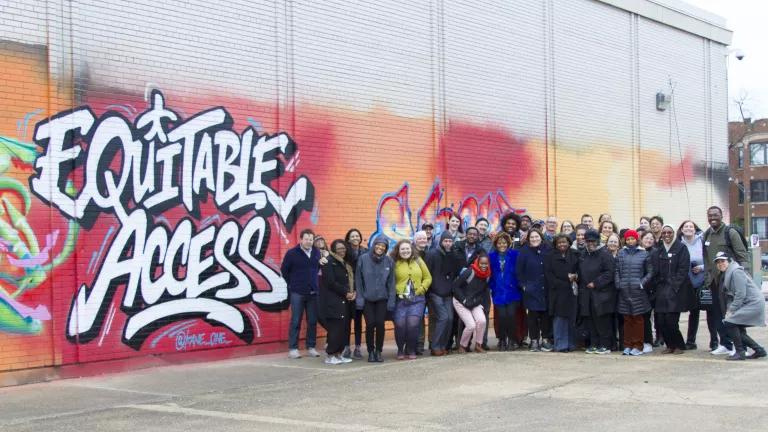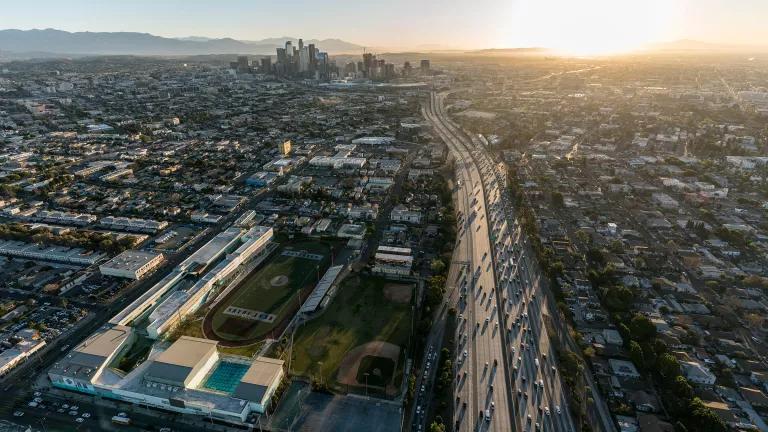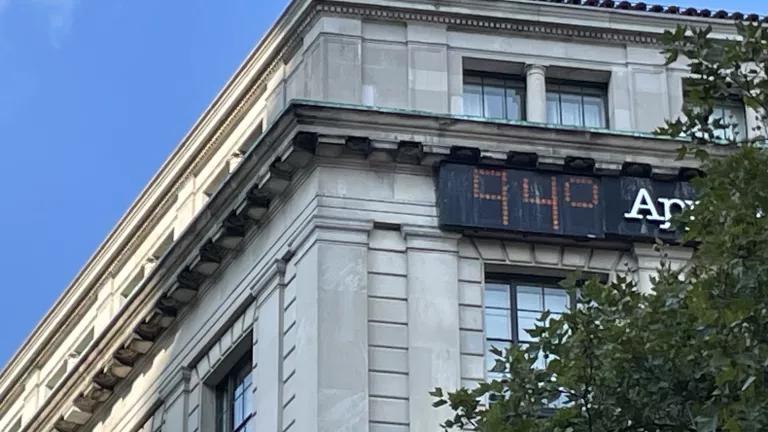2021 Weather Disasters Show Mounting Costs of Inaction
It’s time for Congress to take the fiscally and morally responsible course of action and pass the Build Back Better Act.
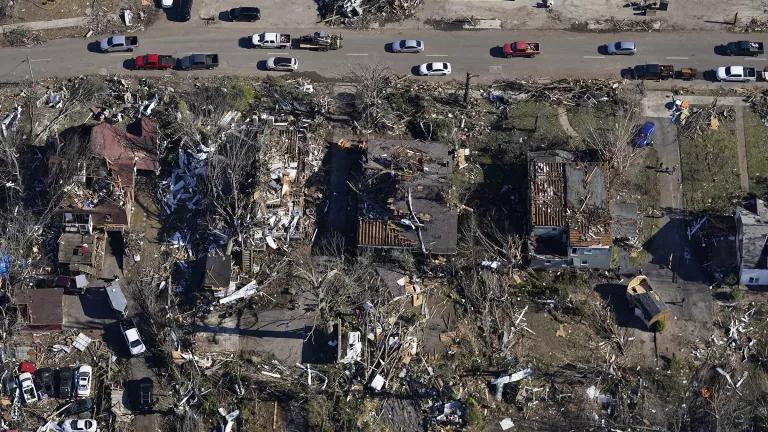
Severe damage caused by the tornado that tore through Mayfield, Kentucky, on December 10, 2021
It’s time for Congress to take the fiscally and morally responsible course of action and pass the Build Back Better Act.
As we close out another year of record-breaking extreme climate and weather disasters—capped by a terrifying fast-moving firestorm in Colorado and the deadliest December tornadoes on record, and summarized in a new report out today from the National Oceanic and Atmospheric Administration (NOAA)—the case for Congress to urgently pass the critical climate change solutions included in the Build Back Better Act has never hit closer to home for more people nationwide.
The stakes are enormous. Failure to act at the scale required will mean a future of ever-increasing health and environmental costs for individuals, communities, and taxpayers. More lives and communities will be devastated by wildfires, extreme weather events, and the deterioration of ecosystems that we depend on for food, employment, and recreation.
Yet opponents of the bill—namely fossil fuel companies and their allies in Congress—have spent the past year trying to kill this effort by trying to scare the public with its price tag. In doing so, they are misleading the public by glossing over just how much inaction is costing all of us already—in terms of straight dollars, but also our health and our lives—and the extent to which the costs dwarf the bill’s price tag and will continue to do so even more, the longer we wait to act.
Opponents are also deflecting the conversation from the direct benefits this legislation will bring to people across the country in terms of jobs created and costs reduced.
And they are not talking about who will pay for it (billion-dollar corporations and the ultra-wealthy) and who will not (everyone else).
As Congress looks to pick back up the Build Back Better Act in the coming weeks, it must consider the tremendous cost of inaction, as demonstrated by NOAA’s most recent report and experienced in communities across the country, and to contrast it with the benefits that the investments of this legislation will deliver to people everywhere in terms of jobs, the economy, our health, our safety, and our quality of life into the future.
If Congress does that, the choice is clear. We cannot afford to not invest in solutions to this widespread and mounting crisis.
Here is just a snapshot of what not passing this bill will cost the people of this country:
A new report out today from NOAA revealed that 2021 was the fourth-warmest year on record in the United States, and the nation saw 20 separate climate and weather disasters, each exceeding $1 billion in damage to property, lands, and infrastructure. These disasters took the lives of 688 people—the highest disaster-related fatalities since 2011 and more than double 2020’s fatalities of 262. The 2021 events ranked second among those recorded in a calendar year, and just behind the record 22 separate billion-dollar events in 2020.
The total cost from damages from these 20 climate and weather events in 2021 was $145 billion, far ahead of the $102 billion in 2020, according to NOAA.
But that’s just a drop in the bucket for what could be coming: According to the congressionally mandated National Climate Assessment, unless action is taken, climate change will cost our economy as much as $500 billion per year by the end of the century.
And none of that even takes into account the health impacts of climate change and burning fossil fuels, which are already costing us more than $820 billion a year in premature deaths, heart disease, respiratory ailments like asthma, hospitalizations, and lost days of work due to illness, a 2021 report from NRDC and partners shows.
These are not just abstract numbers. These climate and weather disasters are touching more and more people in this country directly, no matter where they live. Last year, 4 in 10 people in the United States—or 40 percent of the population—lived in a county struck by a climate disaster.

People evacuate amid thick smoke from the Marshall Fire in Boulder County, Colorado, on December 30, 2021
This past December alone, more than 100 million people in the U.S. were placed under weather alerts, including tornadoes, wildfires, and wind gusts up to 100 miles per hour (mph). That includes the firestorm fueled by raging winds outside of Denver just before New Year’s Eve that burned nearly 1,100 homes, injured at least seven, and displaced tens of thousands of people, following an extremely dry fall and amid a winter nearly devoid of snow.
And it includes dozens of tornadoes that swept across the Midwest this past December—more than any December on record, including the longest path of any tornado in American history—which killed 90 people.
The 20 climate and weather disasters in 2021 included:
- 1 winter storm/cold wave event (across many states, including Kentucky, Louisiana, Oklahoma, Tennessee, and Texas)
- 1 wildfire event (western wildfires across Arizona, California, Colorado, Idaho, Montana, Oregon and Washington)
- 1 drought and heat wave event (across western United States, including California, Oregon, and Washington)
- 2 flood events (in California and Louisiana)
- 3 tornado outbreaks (including the December tornado outbreaks across Arkansas, Kentucky, Missouri, and Tennessee)
- 4 tropical cyclones (Elsa, Fred, Ida, and Nicholas that impacted the East and South).
- 8 severe weather events (across many parts of the country, including the December Midwest derecho (hitting Iowa, Kansas, Minnesota, Nebraska, and Wisconsin)
Since 1980, the United States has been hit by 358 weather and climate disasters, where each one caused more than $1 billion in damages. The total price tag: more than $2.086 trillion.
The growing threat to the economy prompted Federal Reserve chairman Jerome Powell to commit last October to adding climate financial risk analysis to the Fed’s work. “Climate change poses significant challenges for the global economy and the financial system,” he said. “The public rightly expects us to work to ensure the financial system is resilient to climate-related financial risks.”
Meanwhile, global temperatures keep rising, further fueling dangerous climate impacts. 2021 is on track to be among the hottest seven years worldwide in history, all of them since 2014, according to an estimate by the United Nations World Meteorological Organization.
And here’s what the investments included in this bill will deliver to the people of this country:
If enacted, the Build Back Better Act will help tackle pollution from power plants and transportation, which together are responsible for two-thirds of the climate emissions in the United States that are contributing to these extreme weather and climate-related disasters—while creating jobs, lowering energy bills, and advancing equitable access to those benefits.
As currently drafted, the bill includes $550 billion over 10 years to speed the shift away from fossil fuels and toward cleaner, smarter ways to power our future.
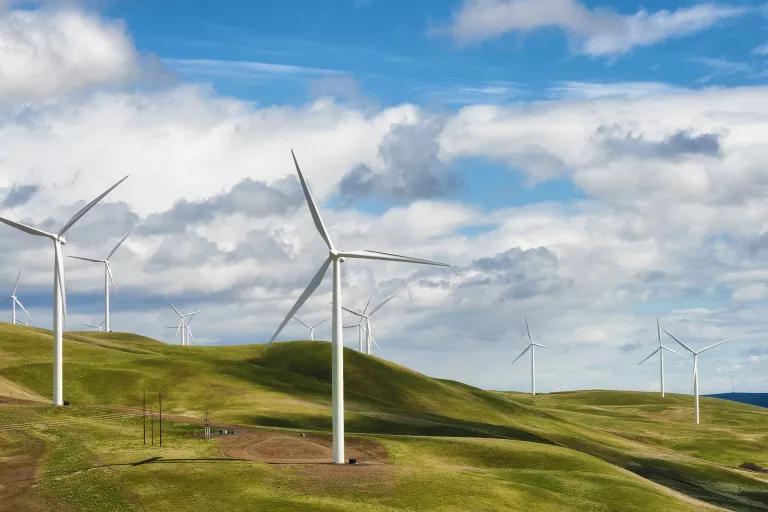
Turbines on Biglow Canyon Wind Farm in Sherman County, Oregon
To put it in perspective, that is $270 billion less than the U.S. health-related costs alone from climate change and fossil fuel pollution. Meanwhile, taxpayers are on track to shell out $200 billion over the coming decade in state and federal subsidies for oil, gas, and coal.
Instead of investing in industries that are threatening our health and costing us money, we should be investing in industries that will save us money, improve our health, and put people to work building a better future.
Specifically, these investments would:
- Help add millions of high-quality jobs in clean energy, an industry that already employs more than three million people in the United States—nearly three times as many as in fossil fuels—with jobs paying 25 percent more than the median wage on average, as shown by the U.S. Bureau of Labor Statistics data.
- Boost energy efficiency investments that will help U.S. households save $500 per year in energy costs on average, including assistance to weatherize homes and put energy-efficient appliances within reach for low-income and middle-class families.
- Create rooftop solar tax credits that will lower costs by 30 percent—along with other incentives to speed the shift to wind and solar power.
- Make new and used electric cars and light trucks more affordable for middle class and lower-income families, as well as businesses. It will also help speed the U.S. auto industry toward 100 percent pollution-free car sales by 2035.
Regarding electric vehicles (EVs):
- Buyers with annual household income below $75,000 would be eligible for a $7,500 tax credit—even more for vehicles built in this country by union workers—that they could apply directly to the price of a new car, and up to $4,000 for any used electric car, van or pick-up truck costing $25,000 or less.
- The bill also upgrades tax credits for businesses that buy EVs for commercial purposes.
- The bill provides investments to help the U.S. Postal Service and other federal agencies shift to EVs.
- And there are bonus incentives to make sure all of these benefits flow to those that need help the most, including low-income communities on the frontlines of climate hazard and harm, and regions that have lost power plants, mines, or other fossil fuel facilities.
Here is who will pay for it—and who will not:
- The funding for the investments in the Build Back Better Act will come from making big corporations and the ultra-wealthy pay their fair share.
- That means no one making under $400,000 a year—nor 97 percent of small businesses—will pay a cent more in taxes.
When you weigh the risks of climate action against inaction, there is only one fiscally and morally responsible course of action: It’s time for Congress to pass the Build Back Better Act, to protect people across the country from the mounting costs and dangers of a crisis we can no longer ignore.
